These past few weeks have been busy! As we slowly emerge from a long winter, a few major changes have come to LY Chinchillas too: we switched from our custom-built digs over to Ferret Nation 182 cages! Admittedly, I went a little crazy with the purchasing process because we ended up with 3 full double units, but after much deliberation on space and convenience, I’ve decided to keep the third double unit boxed up and in storage until more space allows for it in the future.
To start, I’ll speak a little about the emotional change that comes with a major cage change. We had built our custom cages with time, energy, and great care, and they turned out great. They were a little less spacious than I had hoped given the constraints of finding a convertible wardrobe unit, but the larger cages had a lot of vertical space for the two mosaic girls Lulu & Fifi, as well as my standard firstborn son Mittenmaus. Koko resided in the top cage partition, as she has never (to this day) displayed an iota of jumping capability. Separately, Muff had a custom cage built out of two smaller unit cages that he simply loved, including a climbing wall and lots of space for his jellybean self to roam and chirp. There were some downsides to the custom cages, but overall, they were built with great love and care with safety and personalities in mind.
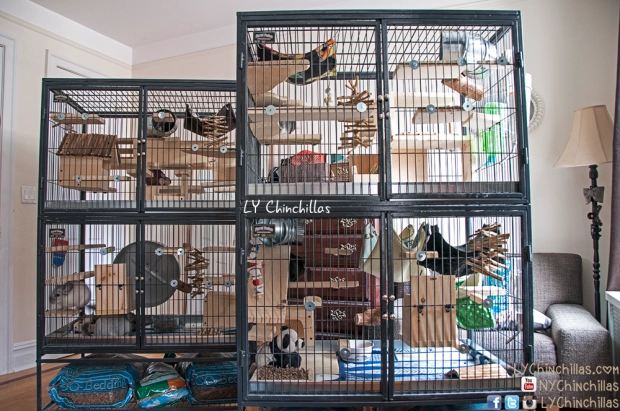
And then, before I knew it, the Ferret Nations were on their way. Honestly, it was a spur of the moment order. I had been thinking about new cages for a while, and after researching options on the market, opted for the 182 model. And then, before I knew it, the Ferret Nations had arrived. The cages have a ton of positive points, but the first few nights were actually filled with anxiety for both me and some of the chins.
The girls didn’t mind at all. They are seemingly more independent and less attached to the comfort of any one place, as if peace of mind is something already engrained in their brains, bringing a sense of ease and calm to their transition. Mitty is an (unsuccessful) escape artist, that’s just how he rolls. He explored his cage to the fullest, memorized each jump and leap and corner, and settled in. Of course, he’s still going forward with his master plan of eventually escaping, and I do wish I could give him a full double unit to himself, but the space is adequate for him and I’m confident that he will adjust over time. Muff, on the other hand, was as nervous as I was. He missed his old cage! Truthfully, this space was a little bit of a downgrade for him, height-wise. The way Muff was acting, I was really starting to doubt my decision. There was a noticeable increase in stress: nervous squeaking, an unwillingness to talk to me or meet my hands, weight loss, and agitated jumping for several days. Part of me wanted to turn back and give him back his old everything, but I made the executive decision to wait and let the new cages settle in – for both me, and the chins.
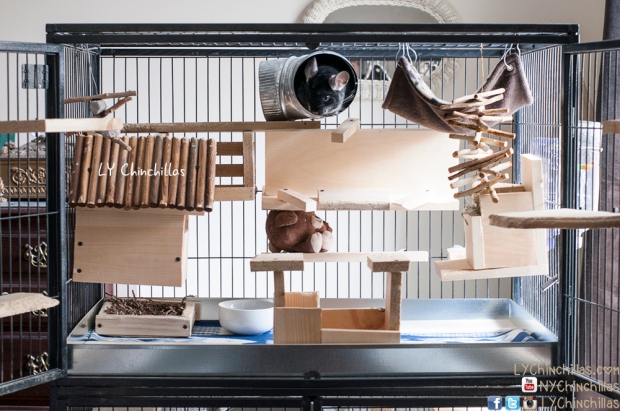

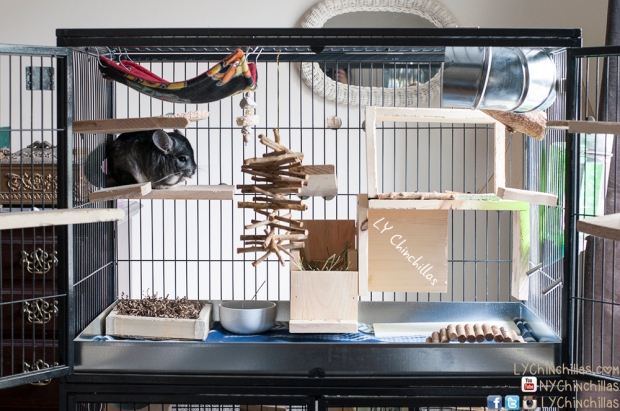

I knew that I purchased these cages for a particular reason: in the hopes that they are the very best, safest, and cleanest option for our living situation right now. Residing in a NYC apartment is not exactly spacious, and every square foot counts. The same day the cages were set up and before I had the chance to reconsider turning back, I had already dismantled the old cages and re-purposed any salvageable kiln-dried pine for ledges and platforms in the new cages. This made it tough, because the moment I started taking parts down, I knew that I wasn’t going to reconstruct the old cages. I had some restless sleep (yes, I’m seriously in tune with my kids) but I lived with it. It was time to move forward. In the following week, all of Muff’s weight loss had been regained, and attitudes from all parties were perking up.
So, that brings me to this very lengthy post – a post which, in many ways, is a formulation of my opinions that are still in infancy. I’ve had the new cages for under a month, and have had some time to modify their interiors to my liking. While I have yet to make any definitive emotional connection with Ferret Nation, I’ve also been forced to put my custom cages in my past. I figured that places me in a unique position to evenly critique the pros and cons of Ferret Nation.
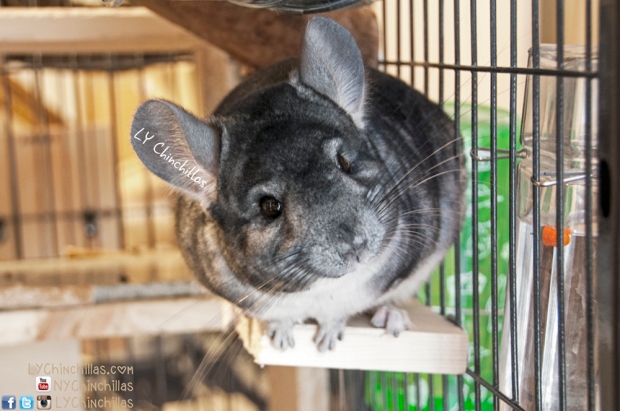
PROS
- User-Friendly, Lots of Control: This is a huge pro! These cages are truly designed for the pet owner, many thanks to Ferret Nation for that. All the points below will simply highlight and point back to this one major pro.
- Reliable Doors: Two self-locking doors that swing open as far as possible? Yes, please! The doors swing open a lovely 225 degrees. This means you can deal with one chinchilla at a time with all the elbow space you need, without having to worry about another chin’s escape.
- Mobility: Smooth wheels do the trick. Rolling the cages from room to room or rotating 360 degrees is totally manageable with one person. I should note that although the wheels have worked fabulously for these first few weeks, a double unit cage is pretty heavy and could cause some wear and tear on the wheel function over time. As mobile as these cages can be, they are more suitable for a stationary situation.
- Light and Ventilation: Nothing sucks more than not being able to see your super cute chinchilla. These cages are awesome for that! Light passes through really easily, making it a little easier to catch the cuteness on camera (which, as chin owners know, is part of the struggle). Bottom levels have a little less light than desired, but such is the payoff for separated top and bottom units. An added bonus of light passage is also air passage, which helps ventilation and improves overall living conditions.
- Universal Nature: So easy to use and self-explanatory, I would consider trusting a pet sitter to handle these cages – and for me, that says a lot.
- Longevity: These cages will last for years. They may get scratched up, but these cages will stay relevant and get the job done.
- Professional Look: The design is simple and sleek.
- Safe and Sturdy: The bars and overall structure is pretty heavy duty, easing the weight of worry on neurotic owners.
- Easy to Clean: A simple structural design makes cleaning as easy as could possibly be! Double unit cages have corners that are easy to reach with (almost) no hidden areas for grime to build up in.
- Resale Value: Hand-in-hand with the “Cost” bullet point in the Cons section, these cages maintain their value pretty well in comparison with other cages.
- Brand Recognition: The commercial value of this product and presence in the industry is pretty solid. This at least means the brand has been somewhat successful long enough to be oft recommended and widely distributed.
CONS
- Customization/Inability to Prorate Space: As customizable as the inside space of the cage may be, the size of each cage is fixed. That means there are three choices: 1, 2, or 3 unit cages. I can’t, for example, give a little more height to the boys or a little more width to my girls without adding another overwhelming unit to their existing spaces.
- More Width Than Height: This might seem like a weird point for some people because most cages are wider than they are high, but with custom cages we had the luxury of being able to customize a safe cage with more height than width, which the chins seemed to love and have more fun with. Of course, you could add on that additional unit and make the height appear, but the overwhelming presence! I would like to point out that this Con is also a Pro, limiting falls and height-related injuries.
- Presence: These cages command attention and space, and definitely carry a presence. A three unit cage would be a little daunting to run into at a friend’s apartment (unless you love chinchillas, which I’m sure most of you do).
- Loud: FN cages consist largely of bars, and these bars reverberate sound against any connected point, such as hammock hangers, washers, and attached ledges. Any jump or leap will produce more sound than wood, which better absorbs vibrations and sounds.
- Bars and Biting: Bar biting is really annoying. Not only is it noisy, but it also leaves a mark – yes, chin chewing can easily create indents and grooves in the cage bars’ powder coating. Behaviorally, it’s a bummer to see your chin trying so hard to escape. Wire mesh in custom cages completely prevents this type of behavior.
- Cleaning Between the Bars: Tough! Dust is the main contender against a totally clean cage situation. Residual dust settles between the bars, and those little nooks are pretty tough to reach and stubborn to clean, even with a high-powered vac.
- Ferret Nation Quality Control: Leaves a bit to be desired. Some details are offset, door locks aren’t symmetrical, plastic panels that I didn’t use arrived shattered and broken, and there were minor scuffs on nearly every piece of metal. Part of these problems are due to their shipping practices (one large cardboard box and no reinforcement) but must also be due to manufacturing practices and company quality control. To be fair, there’s a limited one-year warranty and FN will replace broken parts, but if there was a higher standard across the board, there would be no need to go through a time-consuming warranty shakedown.
- Plastic Bottoms and Platforms: I know there’s a profit to be made, but I could never understand why high-volume national suppliers don’t switch to metal instead of providing their customer’s pets with low quality edible plastic, which can cause blockage or worse. From a caring owner’s standpoint, I’d have hoped for a better industry standard by now. Anyhow, I had to order custom metal pans at an additional cost (which were a great investment, and I’m very happy with).
- Shaking: Although somewhat subtle, the cages will shake from side to side if your chins are running on their wheels.
- Cost: The cost is relatively high, but as would be a custom cage of a similar size.
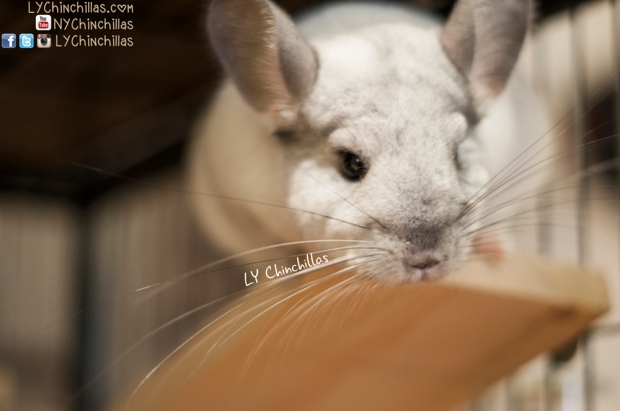
The takeaway? These cages are great for our status quo. Make no mistake about it: when the time comes to buy a house in the country, I have grand plans to painstakingly build fully customized cage mansions for each of the chins (blueprints are already on hand). For now, Ferret Nations will do the job, and do the job relatively well. Stay tuned for future posts about FN cage customization! 🙂
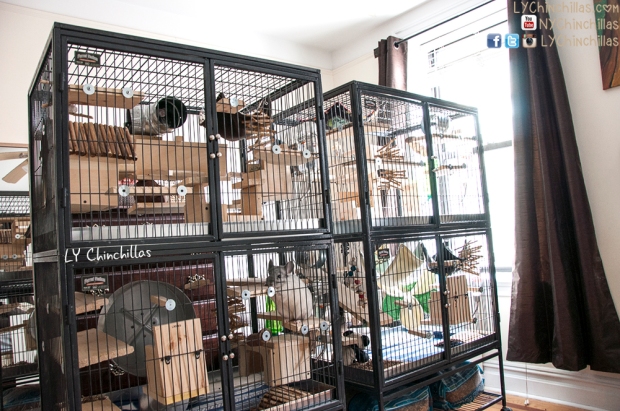

LY Chinchillas Treat Donation
Donate healthy, delicious treats to LY Chinchillas to help keep our content going!
$5.00















